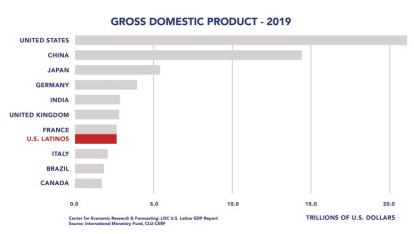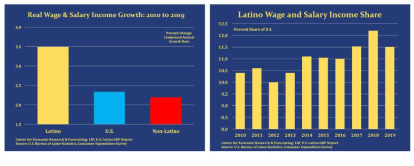Hispanics in the USA: the world's seventh largest economy
If the Hispanic community's economy were independent, it would surpass countries such as Italy, Brazil or Canada. These are the keys to its growth.

(Clotee Pridgen-Wikimedia)
The Hispanic population in the United States now exceeds 62 million inhabitants. This is one of the figure that reveals the importance of this community in the country. If we were talking about an independent economy, the GDP of Hispanics in the U.S. would be equivalent to the seventh largest economy in the world.
The 2021 LDC U.S. Latino GDP Report reflects this spectacular growth. The economic strength of the Hispanic population in the USA would only be surpassed in its Gross Domestic Product by the United States as a whole, China, Japan, Germany, India and the United Kingdom. The GDP generated by Hispanics in the U.S. would tie with France and surpass countries such as Italy, Brazil or Canada.

Producto Interior Bruto en 2019. Fuente: Latino Donor Collaborative-Fondo Monetario Internacional.
Spectacular growth in the Hispanic economy
Total Hispanic economic output was $2.7 trillion in 2019; this is way up from the $2.1 trillion in 2015 and $1.7 trillion in 2010. In short, Hispanic GDP increased by $1 trillion in a decade.

Evolución del PIB US-Hispanos en una década. Fuente: U.S. Bureau of Economic Analysis, CERF @ California Lutheran University
These data are reflected in an economic potential that continues to grow. While in 2000 its purchasing power was estimated at 495 billion dollars, in 2016 it had grown by 181%, reaching 1.4 trillion. Recent analyses forecast an increase up to 2.6 trillion dollars.
The Hispanic community's growth rate is six times higher than that of the rest of the population. In addition, their participation in the labor force is increasingly relevant. In recent years, Hispanic GDP growth has averaged more than 5.5%, doubling that of the U.S. economy as a whole.
According to the LDC report, the most important industry in Hispanic GDP, by sector, is education and healthcare, with a total of $446 billion (16.4% of Hispanic GDP in the country). It is followed by professional and business services (12.0%) and finance and property (9.3%).
Unstoppable Hispanic Consumption
One of the largest components of rapid Hispanic GDP growth since 2010 is personal consumption growth. In 2019, Hispanic consumption stood at $1.85 trillion, (68% of Hispanic GDP). Hispanics represent a consumer market that is nearly identical in size to the entire Texas economy.
From 2010 to 2019, the community's real consumption grew 123 percent faster than that of non-Hispanics. This growth shows no signs of slowing down and has been driven by rising personal incomes. Rapid Hispanic gains in education and strong labor market participation are pillars of this growth.
Average annual real wage and salary growth was 2.3% between 2010 and 2019 in the country. Hispanic wage income growth averaged 3.5%. Although the community has a lower per capita income than non-Hispanics, strong income growth drives consumption and the dramatic explosion of Hispanic GDP in the country.

Crecimiento salarial de la comunidad hispana. US Latino GDP Report. Latino Donor Collaborative.
The Hispanic world is booming. This community is not only growing at a spectacular rate, but is already a fundamental part and an engine of prosperity of the world's leading economy.
RECOMMENDATION





















